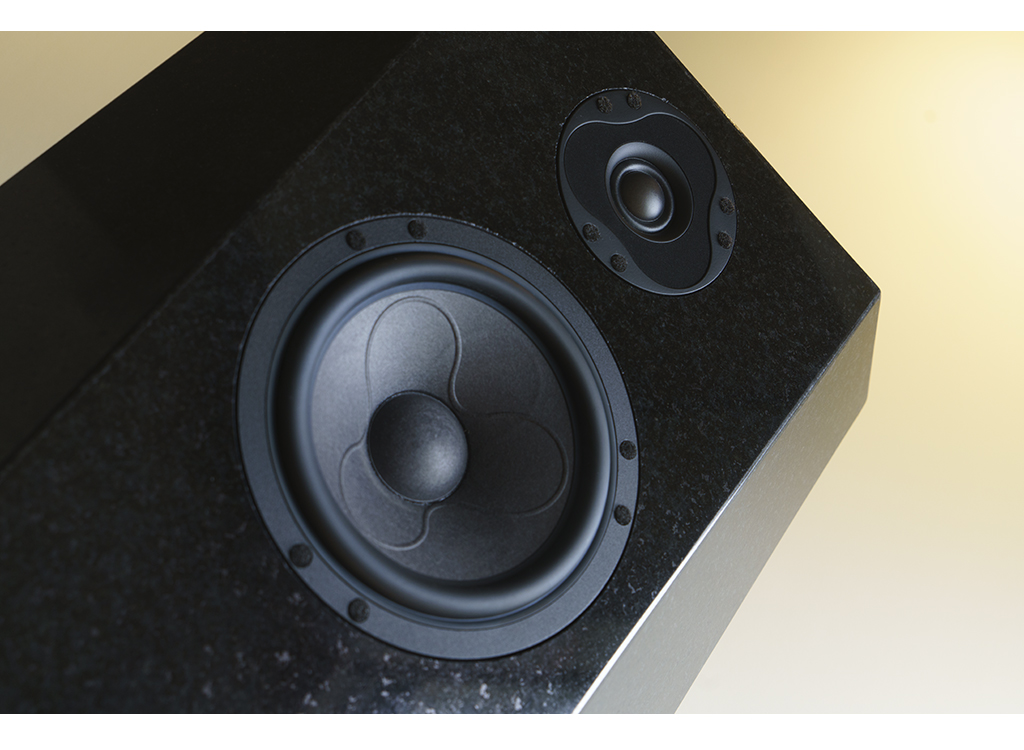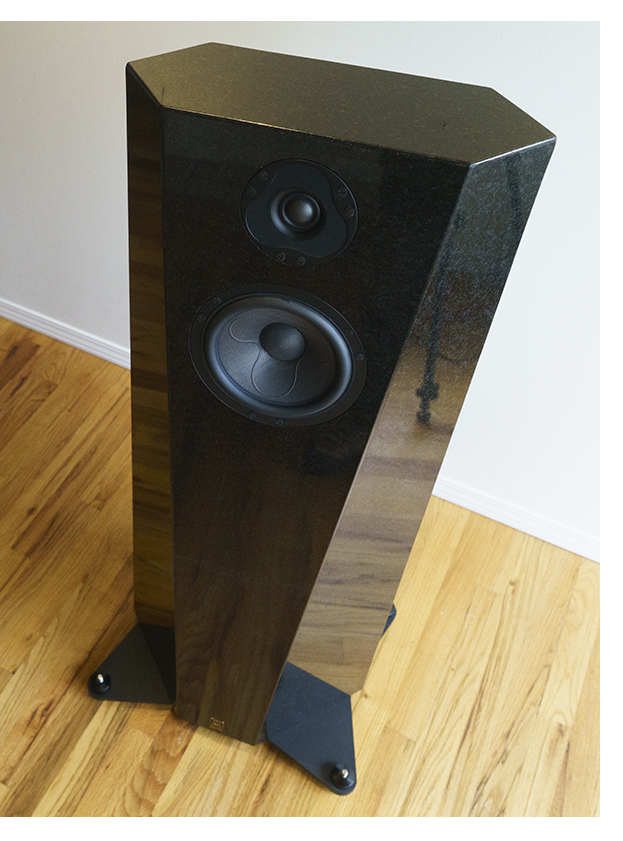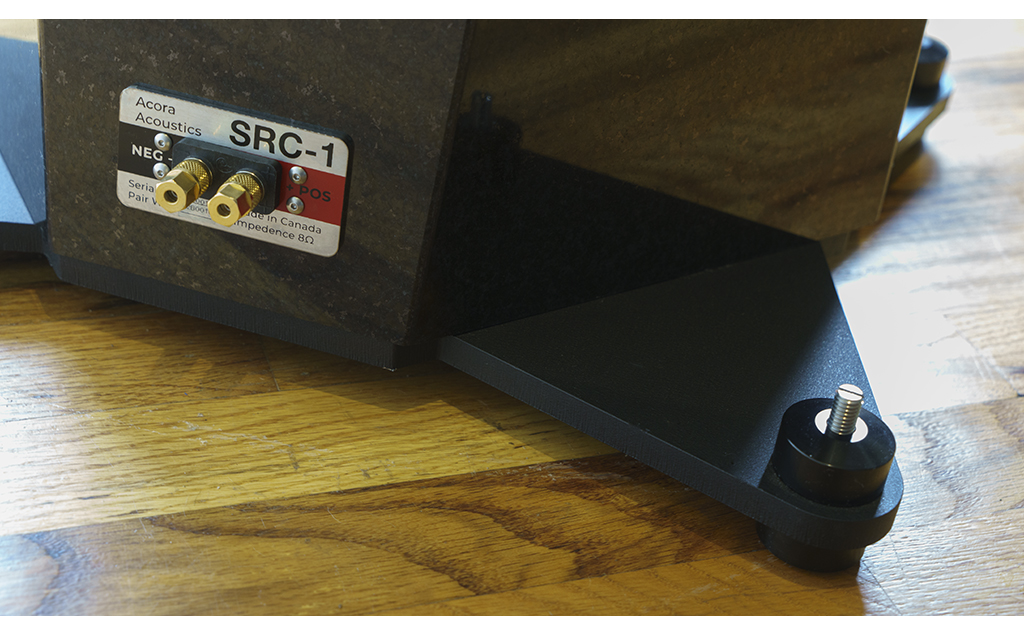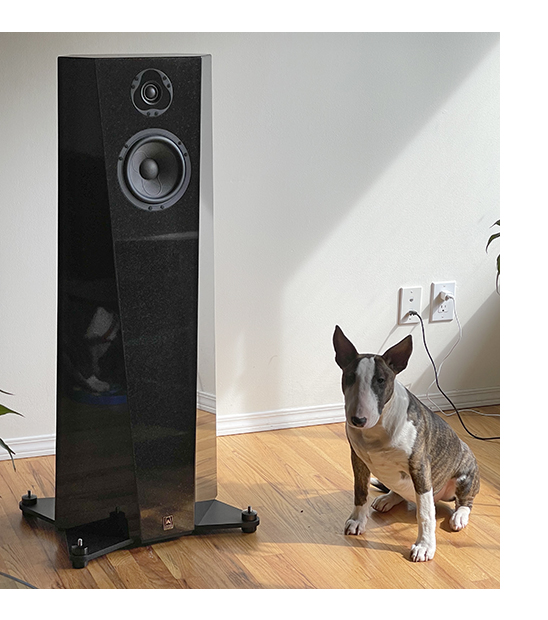Acora SRC-1 Speakers Miraculous In Many Ways
By Jeff Dorgay Acora’s Scott Sefton opened the door with their stand mount SRB speakers a while back, delivering a lovely experience. Even their stand mount speakers generate a lot of low-frequency energy from a compact enclosure.
Acora’s Scott Sefton opened the door with their stand mount SRB speakers a while back, delivering a lovely experience. Even their stand mount speakers generate a lot of low-frequency energy from a compact enclosure.
Like a well tuned, high-performance car, it’s not just one aspect of the speaker that excites the senses. Still, a system that all parameters have been carefully optimized from driver choice to crossover components to their inert cabinets – made entirely of granite.
Valerio Cora, the man who designs the Acora speakers, chooses different driver combinations for each of their three loudspeakers for best effect. A casual look makes it seem like he’s merely added a larger woofer and then two in the bigger SRC-2 model. This is not the case.
Where the SRB uses a beryllium tweeter, the SRC-1 features a soft dome tweeter. This accounts for the SRC-1 sounding slightly less forward than the SRB. It’s not a huge difference, much like moving back about five seats in a good hall. The largest speaker in their range offers more bass extension and dynamic ability as well. In this respect, the Acora speakers remind me of a Magnepan or the old Acoustat ESL speakers in that you choose the speaker for the size room you intend to place it in.
All three speakers share a family sound delivering a relatively similar performance when used in the correct sized room. Other a little bit of ultimate bass extension, the SRB in a small room at modest to loud levels sounds remarkably similar to the bigger Acora models in progressively larger rooms. This is no small engineering feat.
Rather than make you wait to the end, here’s the money quote: the SRC-1 is the most neutral speaker I’ve had the pleasure of listening to. We are keeping these to become part of my living room reference setup because they are such a great place to start when reviewing other components. They are that good. Will they be the speaker for you? Read on and see if this approach makes sense. I’ll do my best.
Lack of coloration
Everyone perceives sound differently (just as we do color), and everyone has different goals for their HiFi system. If your priorities lean towards tonal accuracy, it’s easy to get too much of a good thing, ending up with strident speakers that wear on you after extended periods in the listening chair. At times, that extra dose of resolution that catches your ear at a HiFi show or in a dealer showroom is too much in your room after a few long days. Hyper detail can be a cruel and painful addiction.
The SRC-1s do not suffer from this issue in the slightest. The closest comparison that comes to mind is the 3000 series Boulder monoblock amplifiers. They are highly resolving yet not fatiguing, imposing no sonic signature of their own. You can listen to them all day without the slightest bit of fatigue or boredom. They offer an unmatched clarity that is unfortunately out of reach for most music lovers at just over $300k per pair. You can’t get that much money for both of your kidneys. At $28,000/pair, the SRC-1s are not out of reach. Easter’s coming; sedate a family member after dinner, snatch a kidney, bam. They won’t miss it.
After 17 years of publishing TONE, we’ve talked to many of our readers via various channels, and you’ve been telling us that a lot of you possess systems in the $50k – $100k range. If you’ve been planning on building a system around this kind of sound, I highly suggest the SRC-1 for many reasons.
Season to taste
Because music is so personal, most of us usually prefer “a sound.” The Acoras let you play it straight, go for a bit more resolution, or a bit more romance simply by switching the components. The Boulder 866 integrated the T+A 2500 and the combination of the Audio Research REF 80S/LS-28SE all provided a more neutral voice during extended listening sessions. The ARC combo is the most resolving of the group, creating a soundfield that is deep, deep, deep. Nagra’s Classic Pre and Amp offered just a touch more dynamic drive than the ARC pair, with slightly more presence in the lower registers but still closer to what we’d consider natural/neutral.
My reference Pass XS Pre/XS Phono/XA 200.8 monoblock combination delivers a warmer tonal balance. Still, the extra current drive helps the SRC-1s produce an even larger sonic landscape than the previous components. Even warmer still, the PrimaLuna EVO 400 Monoblocks (with KT-150 tubes) shrink the sonic space slightly but add tons of personality, embellishing the midrange as a classic tube amplifier is wont to do.
Acora’s 90.5dB/1-watt sensitivity rating only tells part of the story. These speakers are very easy to drive with anything. Should you be an audio enthusiast that loves single-ended triodes, again, the SRC-1s provide a lovely presentation. Bringing the CARY 805 monos front and center produces a very colored but oh-so-magical SET vibe to the party. Going through a long playlist of vocal and acoustic tracks proves immersive and beguiling. If your musical taste is heavily weighted in this direction, you could happily live here.
It will be tricky to find electronics that will out resolve the SRC-1s unless you have Ferrari money at your disposal. The good news is, whether you purchase a pair of SRC-1s as the endcap on your audio system or use them to explore a wide range of components, cables, and recordings, they are incredibly versatile.
Further listening
The Acora speakers will bring a lot of “wow, I didn’t hear that before” or “I didn’t hear it like that before” moments. Rather than bore you with what seems like an endless barrage of record reviews, forcing my questionable musical taste upon you, suffice to say, these speakers will keep you riveted to your listening chair for hours.
The more time spent listening to these speakers the more challenging it is to describe the lack of sound and voice they possess. Treble is extended but not harsh, tizzy, or tipped up, and bass is equally extended, with a high level of resolution. All but the most hard-core electronica listeners should find the lower registers of these speakers more than adequate.
Interestingly, Acora suggests no toe-in for setup, and while this seemed a little counterintuitive at first, it works wonders. Bringing the speakers a little closer in (we ended up about 6 feet apart in the small room and 8 feet apart in the big room) and eliminating toe-in dramatically increases horizontal image size and image precision. At 246 pounds each, get a friend to help you to place the SRC-1s before you install the spikes, or you could damage something. You might jump to the conclusion from my pictures that I have the speakers “set up wrong,” because the screw adjusters are showing. What I’ve done here, and I suggest for anyone with hardwood floors, is to use the black cups that normally would screw on top here, (and finely finished they are) to use OVER the spikes, acting like pucks. As I have an older home and wasn’t quite sure just how much weight per square inch would work, I decided to be safe rather than sorry.
At the beginning of the review, there was a passing reference to planar and electrostatic speakers. I have always had an admitted bias towards coherence over almost anything else, and in this aspect, the Acoras excel. They feel like a single-driver speaker, but with extension and dynamics. Combined with the inert cabinet, these speakers disappear in the room like few others.
And, those cabinets
Now that I have a wily pair of Bull Terriers zooming around my house, pet-friendly speakers have become more of a priority. Lucy and Ricki’s massive teeth can’t touch that granite enclosure, and at almost 300 pounds each, they can not tag-team them to the floor either. I’m guessing the same amount of non-destructibility applies to those of you with toddlers as well.
The granite also makes for an incredibly inert way to mount drivers – making for an enclosure that simply lets the drivers do their thing. While companies like Sonus faber, Harbeth, and others “tune” the cabinet to work with their drivers, once you hear the purity of Acora’s approach, you’ll always hear the cabinets elsewhere, at least to some extent. (And I say this as a Harbeth and Sonus faber owner.)
Practicality aside, the SRC-1s are beautiful. Not entirely as black as the Spinal Tap album cover, they still have some detail in the black, looking absolutely beautiful when light hits them. They are austere enough that they should work within any décor, though they probably lend themselves to a more modern room. As does everything black. The amount of time and precision to cut granite to this level of accuracy should not be overlooked either. The cabinet joints and driver cutouts are perfectly executed.
Are they your cup of?
The toughest part of writing about products like this (i.e., ones you really like) is not sounding like a fanperson. But, I genuinely hope that if the description of the SRC-1s sounds intriguing, you’ll seek out a pair to listen to. These really have been a favorite. Very few speakers can serve double duty as a reviewing tool yet provide hours of musical enjoyment when not in gear evaluation mode.
Having a speaker with such a natural presentation on its own makes for a $28,000 pair of speakers you can keep around for a very long time – maybe forever. When you consider the expense of buying and selling multiple pairs of $10k speakers (and losing a few thousand bucks every single time) putting the SRC-1 in your system and getting your sonic moods satisfied by merely changing electronics is a pretty good value at the end of the day. Actually an Exceptional Value Award.






